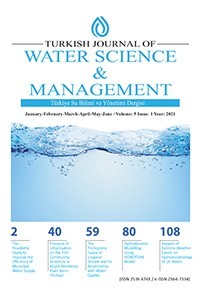Investigating the Suitability of Drainage Channels Water for Irrigation in Bafra Plain
Investigating the Suitability of Drainage Channels Water for Irrigation in Bafra Plain
drainage, bafra plain, paddy,
___
- Anonymous. (2004).Turkish environmental legislation. Water pollution control regulation. www.resmigazete.gov.tr.
- Ayers, R. S. & Westcot, D.W. (1985). Water quality for agriculture. FAO irrigation and drainage paper 29 Rev. 1. Food and Agricultural Organization. Rome.
- Ayyıldız, M. (1990). Sulama suyu kalitesi ve tuzluluk problemleri [Irrigation water quality and salinity problems], Ankara Üniversitesi Ziraat Fakültesi Yayınları, 1196.
- Bahçeci, İ., Tarı, A.F. & Dinç, N. (2007). Konya ovası yüzey altı drenaj sistemlerinde taban suyu ve drenaj sularının sulamada kullanılma olanakları [The Possibilities for drainage water reuse under conditions of constructed subsurface drainage systems in Konya Plain], Selçuk Üniversitesi Ziraat Fakültesi Dergisi, 21(3), 7-13.
- Cemek, B., Güler, M. & Arslan, H. (2006). Bafra ovası sağ sahil sulama alanındaki tuzluluk dağılımının coğrafi bilgi sistemleri (CBS) kullanılarak belirlenmesi [Determination of salinity distribution using GIS in Bafra Plain right land irrigated area], Atatürk Üniversitesi Ziraat Fakültesi Dergisi. 37 (1), 63-72.
- Çiftçi, N., Yilmaz, M.A. & Kara, M. (1995). Konya ovası drenaj sebekelerinde su kalitesinin yıllık degisimi ve sulamada kullanılabilirligi [Annual variation of water quality of drainage channels in Konya Plain and usability for irrigation], V. Kültürteknik (Sulama) Kongresi, Kemer, Antalya. (Turkish)
- Eaton, F.M. (1950). Significance of carbonates in irrigation waters. Soil Science, 69, 123-133.
- EPA (1994). United State Environmental Protection Agency. Water quality standards Handbook.
- Erözel, Z. & Çakmak. B. (1993). Drenaj suyunun sulamada kullanılması [Re-use of drainage water for irrigation], Topraksu Dergisi, 2-6
- Fipps, G. (1994). Irrigation water quality standarts and salinity management.
- Kanber, R. (1999). Sulama ders kitabı [Irrigation book], Adana.
- Özer, N., & Demirel, F.A. (2003). Şanlıurfa ve Harran ovalarında işletme aşamasında taban suyu ve tuzluluk problemleri, [Basin water and salinity problems in Şanlıurfa and Harran plain] II. Ulusal Sulama Kongresi Bildirimleri, Aydın, 193-199.
- Singh, M. & Dahiya, I.S. (1979). Simultaneous transport of surface salt and water through unsatured soils during infiltration and redistribution. Soil Science Plant Analysis, 10, 591-611
- Tüzüner, A. (1990). Toprak ve su analiz laboratuvarı el kitabı [Hand Book of Soil and water analysis], Ankara.
- Wilding, L.P. (1985). Spatial variability: its documentation, accommodation and implication to soil surveys. In: Nielsen DR, Bouma J(eds) Soil Spatial Variability. Pudoc, Wageningen, 166-194.
- ISSN: 2536-474X
- Başlangıç: 2017
- Yayıncı: Tarım ve Orman Bakanlığı Su Yönetimi Genel Müdürlüğü
Investigating the Suitability of Drainage Channels Water for Irrigation in Bafra Plain
Bilal CEMEK, Kadir GÜLER, Erdem KÜÇÜKTOPCU
Common Diatoms of Phytobenthos in Gediz River Basin
Cüneyt Nadir SOLAK, Tolga ÇETİN, Yakup KARAASLAN, Aydın KALELİ, Elif YILMAZ, Mustafa DURAN, Gürçay KIVANÇ, Taner KİMENÇE, Şebnem AYNUR KOYUNLUOĞLU, Fuat ÇANKAYA, Deniz YILMAZ
Drinking Water Treatment Plants in Turkey and Determination of Revision Needs
Esra GİRESUNLU, Arife ÖZÜDOĞRU, Fulya YAYCILI, Hilal UFLAZ, Cenk GÜMÜŞKAYA, Murat SARIOĞLU, Yakup KARAASLAN
Cost Optimization of Hanoi Water Distribution Network with Meta-Heuristic Optimization Algorithms
